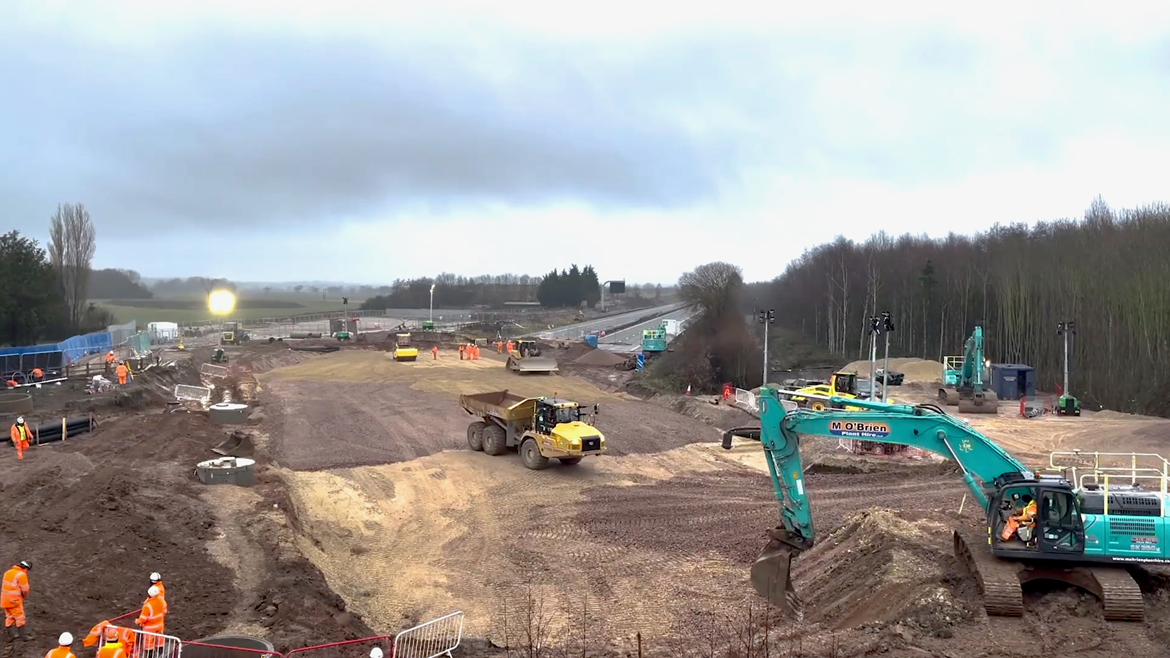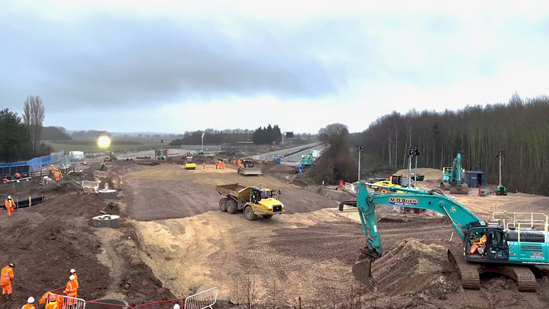Newly released time-lapse footage shows complex preparation work for HS2’s Marston Box bridge over the M42 during a week’s closure of a section of the motorway in December 2021. The video shows the Balfour Beatty VINCI (BBV) site team working around the clock to deliver the intricately planned operation in just seven days.
During the M42 closure between Junction 9 and 10, the team removed the existing surface of the motorway where the bridge will be located, created a three metre deep cutting, installed and connected new drainage, created foundations and improved the stability of the ground to support the weight of the bridge. They also replaced motorway barriers, and installed additional safety barriers and a new surface to enable the motorway to re-open to road users on time.
The work was carried out in preparation for the UK’s first ‘box slide’ of a railway bridge over a motorway. The innovative technique involves building the entire structure on land next to the motorway and then using a guide raft to slide it into place. This dramatically cuts down disruption to road users and forms part of HS2’s plan to reduce the impact of construction on local communities.
The 10,000 tonne bridge structure will have a base, three walls and top slab and will be built over the coming months. It is due to be slid into place on a hi-tech raft towards the end of 2022, during a second one-week motorway closure.
The bridge was originally designed as a traditional structure, which would have meant significant traffic disruption for motorway users, with around two years of reduced lane widths, 50mph speed limits and weekend and night closures.
David Speight, Client Project Director, HS2 Ltd said:
“By using pioneering innovations like the box-slide technique, HS2 is improving both the safety and speed of works on the project, as well significantly reducing disruption. This was a complex and intricately planned groundwork operation, with a huge amount of work carried out by the teams during just one week. The successful delivery is testament to the skills and expertise of over 100 people in the BBV team, along with their specialist supply chain companies.”
Emmanuel Costes, Project Director at Balfour Beatty VINCI (BBV) said:
“Wherever we operate, we always seek to minimise disruption to local communities and the travelling public; closing the M42 during the quiet Christmas period whilst we undertook these essential preparatory works.
“With preparatory works now complete, we are looking forward to utilising our deep-domain knowledge and expertise to successfully complete the ‘box-slide’ later this year – the first time this innovative construction method has been utilised on a motorway in the UK.”
Two tower cranes will soon arrive on the site next to the motorway to help build the ‘guide raft’ - a reinforced 172metre x 21metre concrete slab. In the Summer, the team will then start construction of the box-shaped bridge on top of the concrete slab, before it is slid into place on the motorway later in the year.
The box slide uses a specialist jacking system designed by civil and structural engineering company, Freyssinet. When activated, the jacking system will slowly push the box across on the guiding raft. Once in motion, the box can reach speeds of over 2m per hour, with the complete ‘slide’ taking only days to complete.
Once built, the Marston Box will connect to Dunton Wood Embankment to the south and the Birmingham and Fazeley Canal Viaduct, which crosses the heritage canal, to the north. On completion, the whole structure will be around 190 metres in length, of which 82 metres will be installed using the box-slide method.
ENDS

